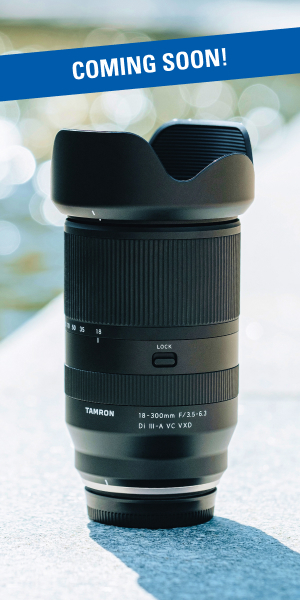Photographing an airshow presents a unique set of challenges—from tracking fast-moving jets to composing compelling shots in difficult lighting conditions. Over the years, I’ve come to depend on Tamron lenses for airshow photography, especially the Tamron 150-600mm for DSLR and 150-500 for mirrorless. These lenses provide the reach, sharpness, and flexibility needed to capture everything from high-speed aerobatics to dramatic parachute drops. I’ve used them successfully with both DSLR and mirrorless Nikon systems, and they perform effortlessly across platforms.
Images and text by Carolyn Hutchins
What You’ll Learn in This Article:
- Why Tamron’s ultra-telephoto lenses are ideal for capturing jet teams and skydivers
- How the Tamron all-in-one zooms simplify airshow coverage
- Tips for handling ultra-telephoto lenses in dynamic outdoor conditions
- How to prepare for lighting, layout, and timing challenges unique to airshows
- Creative framing ideas for both flight demonstrations and ground-level storytelling
Capturing Fast Jet Formations with the Tamron 150-600mm

In 2024, the main performers at Sun ‘n Fun were the US Air Force Thunderbirds, an aerobatic team of F-16s. To get tight images, I use the 150-600, as it provides great reach, but also goes wide enough for me to capture multiple jets when they are flying in formation.
It’s sharp and picks up the smaller details, so I also use this lens for the skydiving teams, here it’s one from the SOCOM Para-Commandos. Because every show begins with a flag jumper during the national anthem, this is an important moment, and the details need to look right (the stars and stripes can’t look like dots and streaks).
Handling and Stability with a Telephoto Lens

But the Tamron 150-600mm F/5-6.3 Di VC USD G2 (Model A022) is not a small lens, which is why practice is important as well. Learn your gear, the more familiar with it you are, the better. Jets move fast, and you will probably not get a second chance to catch something. For me, one of the biggest challenges is balance. I am not a tall person, and even without being extended or having the lens hood on, the 150-600 is half of my forearm.
So, when I am stationed on a small platform, and in strong wind, stabilization can be a challenge. Through (a lot of) practice, I have figured out the best ways to stand, brace myself, and move along with the subjects I happen to be tracking.
Versatility for Evening Shows and Prop Planes
For the evening shows, I tend to use the discontinued Tamron 18-400 on my DSLR a bit more. With less light in the sky and more prop aircraft, the need arises for slower shutter speeds. The 18-400, like the new 28-300mm F/3.5-6.3 Di III VC VXD for mirrorless, is smaller and lighter that the ultra telephoto zoom, giving me the ability to move quicker, while still giving me the zoom reach that I need.
Here, RJ Gritter is flying aerobatics in a high wing airplane at sunset. So, for this situation, it was all about the colors. The bright pattern of the aircraft stands out very strongly against the colors of the sky, and that’s what I really wanted to capture.
Documenting the Full Airshow Experience
In addition to the actual flights, I also must document many other aspects of the show. Tamron all-in-one zooms are unmatched in the versatility of range, making them easy to turn around and capture images of the people as I make my way throughout the grounds, and saving me a great deal of time by not having to change lenses from one assignment to the next.
Planning and Positioning for Success
Like anything, it’s important to prepare for airshows. Pay attention to obvious things like weather, but also give thought to the layout of the airport. Is the runway east/west or north/south? Where do the aircraft taxi in and out? Where will the sun be facing at times of the show? What exactly do you want to capture? Propeller aircraft? Jets? Static displays?
Some of my favorite places to shoot from are not actually at the show center, in fact, the two 4 plane formation images of the Thunderbirds were both taken from the eastern end of the runway. So, while there can be quite a lot to consider, a little bit of research for your individual situation will go a long way.
Final Thoughts: Why Tamron Lenses Are a Top Choice for Airshow Photography

Photographing an airshow is about more than just pointing a long lens at the sky—it’s a dynamic blend of preparation, timing, and gear. Tamron lenses for airshow photography, like the 150-600mm G2 and 18-400mm, have proven to be reliable tools for capturing everything from precision jet teams to colorful evening aerobatics and candid moments on the ground. Their versatility, reach, and clarity help ensure you don’t miss a moment—whether you’re tracking fast-moving subjects or switching quickly between wide and tight shots. With the right lens and a bit of planning, you’ll be ready to capture the thrill and spectacle of airshows from every angle.
Learn about Tamron all-in-one and telephoto zoom lenses for your next airshow. Find an authorized Tamron dealers in your area or visit the TAMRON Store today.
More Photo Tips | Watch Videos | Learn More About Tamron Lenses | Photo Gallery


